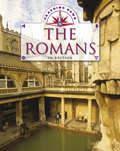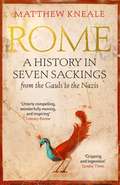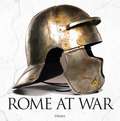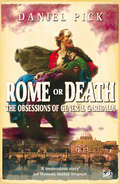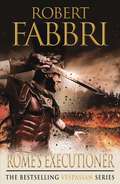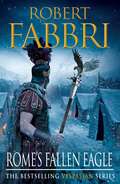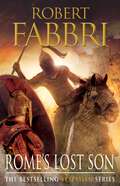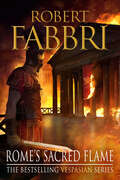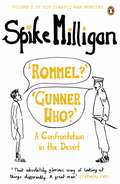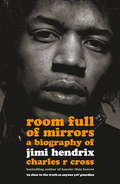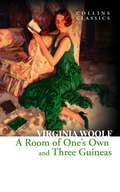- Table View
- List View
The Romans in Britain: The Romans In Britain (Tracking Down #14)
by Moira Butterfield'The past is all around us, if we know where to look.' This series takes a look at archaeological, structural and museum evidence from around Britain, allowing readers to build up a picture of what life was like in key historical periods and how you can discover it for yourself by visiting sites around the country.
Rome: A History In Seven Sackings
by Matthew KnealeA SUNDAY TIMES BESTSELLERWaterstone's Book of the Month, 2018Nominated for the 2017 Pen Hessell-TiltmanDaily Telegraph's Best History Books of 2017Sunday Times' Best History Books of 2017A sweeping history of the city of Rome, seen through the eyes of its most significant sackings, from the Gauls to the Nazis and everything in between.No city on earth has preserved its past as Rome has. Visitors can cross bridges that were crossed by Cicero and Julius Caesar, explore temples visited by Roman emperors, and step into churches that have hardly changed since popes celebrated mass in them sixteen centuries ago.These architectural survivals are all the more remarkable considering the many disasters that have struck the city. Rome has been afflicted by earthquakes, floods, fires and plagues, but most of all it has been repeatedly ravaged by roving armies. From the Gauls to the Nazis, Matthew Kneale tells the stories behind the seven most important of these attacks and reveals, with fascinating insight, how they transformed the city - and not always for the worse. Using this entirely new approach to Rome's past he unveils how it became the city it is today. A meticulously researched, magical blend of travelogue, social and cultural history, Rome: A History in Seven Sackings is a celebration of the fierce courage, panache and vitality of the Roman people. Most of all, it is a passionate love letter to this incomparable city.'A masterpiece of pacing and suspense' Sunday Times'Fascinating... A delight' The Times 'Book of the Week'
Rome: Strategy of Empire
by James LaceyThe first work to lay out Roman strategic thinking from its start under Augustus until its final demise in 476 CE From Octavian's victory at Actium (31 bc) to its traditional endpoint in the West (476), the Roman Empire lasted a solid 500 years—an impressive number by any standard, and fully one-fifth of all recorded history. In fact, the decline and final collapse of the Roman Empire took longer than most other empires even existed. Any historian trying to unearth the grand strategy of the Roman Empire must, therefore, always remain cognizant of the time scale, in which she is dealing. Although the pace of change in the Roman era never approached that of the modern era, it was not an empire in stasis. While the visible trappings may have changed little, the challenges Rome faced at its end were vastly different than those faced by Augustus and the Julio-Claudians. Over the centuries, the Empire's underlying economy, political arrangements, military affairs, and, most importantly, the myriad of external threats it faced were in constant flux, making adaptability to changing circumstances as important to Roman strategists as it is to strategists of the modern era. Yet the very idea of Rome having a grand strategy, or what it might be, had not concerned historians until Edward Luttwak's The Grand Strategy of the Roman Empire appeared forty years ago. Although this pioneering work generated much debate, it failed to win over many ancient historians, in part because of its heavy emphasis on military force and its neglect of considerations of diplomacy, economics, politics, culture, and the changing nature of the threats that confronted Rome. By employing an expansive definition of strategy and by focusing much of the narrative on crucial historical moments and the personalities involved, James Lacey provides a comprehensive, persuasive, and engaging account of the rise and fall of the Roman Empire. It assimilates the most recent work of classical historians and archaeologists to correct the flaws and omissions of previous accounts, thus presenting the most complete and nuanced narrative of Roman strategic thinking and execution ever published.
Rome: Strategy of Empire
by James LaceyThe first work to lay out Roman strategic thinking from its start under Augustus until its final demise in 476 CE From Octavian's victory at Actium (31 bc) to its traditional endpoint in the West (476), the Roman Empire lasted a solid 500 years—an impressive number by any standard, and fully one-fifth of all recorded history. In fact, the decline and final collapse of the Roman Empire took longer than most other empires even existed. Any historian trying to unearth the grand strategy of the Roman Empire must, therefore, always remain cognizant of the time scale, in which she is dealing. Although the pace of change in the Roman era never approached that of the modern era, it was not an empire in stasis. While the visible trappings may have changed little, the challenges Rome faced at its end were vastly different than those faced by Augustus and the Julio-Claudians. Over the centuries, the Empire's underlying economy, political arrangements, military affairs, and, most importantly, the myriad of external threats it faced were in constant flux, making adaptability to changing circumstances as important to Roman strategists as it is to strategists of the modern era. Yet the very idea of Rome having a grand strategy, or what it might be, had not concerned historians until Edward Luttwak's The Grand Strategy of the Roman Empire appeared forty years ago. Although this pioneering work generated much debate, it failed to win over many ancient historians, in part because of its heavy emphasis on military force and its neglect of considerations of diplomacy, economics, politics, culture, and the changing nature of the threats that confronted Rome. By employing an expansive definition of strategy and by focusing much of the narrative on crucial historical moments and the personalities involved, James Lacey provides a comprehensive, persuasive, and engaging account of the rise and fall of the Roman Empire. It assimilates the most recent work of classical historians and archaeologists to correct the flaws and omissions of previous accounts, thus presenting the most complete and nuanced narrative of Roman strategic thinking and execution ever published.
Rome – City in Terror: The Nazi Occupation 1943–44
by Victor FailmezgerIn September 1943, following wave upon wave of Allied bombing, Italy announced an armistice with the Allies. Shortly afterwards, the German army disarmed Italian forces and, despite military and partisan resistance, quickly overran Rome. Rome – City in Terror is a comprehensive history of the nine-month-long German occupation of the city that followed.The Gestapo wasted no time enforcing an iron grip on the city once the occupation was in place. They swiftly eliminated the Carabinieri, the Italian paramilitary force, rounded up thousands of Italians to build extensive defensive lines across Italy, and, at 5am one morning, arrested more than 1,000 Roman Jews and sent them to Auschwitz. Resistance, however, remained strong. To aid the thousands of Allied POWs who escaped after the dissolution of the Italian army, priests, diplomats and escaped ex-POWs operating out of the Vatican formed a nationwide organization called the 'Escape Line'. More than 4,000 Allied POWs scattered all over Italy were sheltered, clothed and fed by these courageous Italians, whose lives were forfeit if their activities were discovered. Meanwhile, as food became scarce and the Gestapo began to raid on homes and institutions, Italian partisan fighters launched attack after attack on German military units in the city, with the threat of execution never far away.This is the compelling story of an Eternal City brought low, of the terror and hardship of occupation, and of the disparate army of partisan fighters, displaced aristocrats, Vatican priests, Allied POWs and ordinary citizens who battled for the liberation of Rome.
Rome – City in Terror: The Nazi Occupation 1943–44
by Victor FailmezgerIn September 1943, following wave upon wave of Allied bombing, Italy announced an armistice with the Allies. Shortly afterwards, the German army disarmed Italian forces and, despite military and partisan resistance, quickly overran Rome. Rome – City in Terror is a comprehensive history of the nine-month-long German occupation of the city that followed.The Gestapo wasted no time enforcing an iron grip on the city once the occupation was in place. They swiftly eliminated the Carabinieri, the Italian paramilitary force, rounded up thousands of Italians to build extensive defensive lines across Italy, and, at 5am one morning, arrested more than 1,000 Roman Jews and sent them to Auschwitz. Resistance, however, remained strong. To aid the thousands of Allied POWs who escaped after the dissolution of the Italian army, priests, diplomats and escaped ex-POWs operating out of the Vatican formed a nationwide organization called the 'Escape Line'. More than 4,000 Allied POWs scattered all over Italy were sheltered, clothed and fed by these courageous Italians, whose lives were forfeit if their activities were discovered. Meanwhile, as food became scarce and the Gestapo began to raid on homes and institutions, Italian partisan fighters launched attack after attack on German military units in the city, with the threat of execution never far away.This is the compelling story of an Eternal City brought low, of the terror and hardship of occupation, and of the disparate army of partisan fighters, displaced aristocrats, Vatican priests, Allied POWs and ordinary citizens who battled for the liberation of Rome.
Rome and the Barbarians, 100 B.C.–A.D. 400 (Ancient Society and History)
by Thomas S. BurnsThe barbarians of antiquity, so long a fixture of the public imagination as the savages who sacked and destroyed Rome, emerge in this colorful, richly textured history as a much more complex—and far more interesting—factor in the expansion, and eventual unmaking, of the Roman Empire. Thomas S. Burns marshals an abundance of archeological and literary evidence, as well as three decades of study and experience, to bring forth an unusually far-sighted and wide-ranging account of the relations between Romans and non-Romans along the frontiers of western Europe from the last years of the Republic into late antiquity.Looking at a 500-year time span beginning with early encounters between barbarians and Romans around 100 B.C. and ending with the spread of barbarian settlement in the western Empire around A.D. 400, Burns removes the barbarians from their narrow niche as invaders and conquerors and places them in the broader context of neighbors, (sometimes bitter) friends, and settlers. His nuanced history subtly shows how Rome's relations with the barbarians—and vice versa—slowly but inexorably evolved from general ignorance, hostility, and suspicion toward tolerance, synergy, and integration. What he describes is, in fact, a drawn-out period of acculturation, characterized more by continuity than by change and conflict and leading to the creation of a new Romano-barbarian hybrid society and culture that anticipated the values and traditions of medieval civilization.
Rome at War
by Bloomsbury PublishingThe Roman Empire was the greatest the world has ever seen, and its legendary military might was the foundation of this success.This compact volume tells the fascinating story of the major conflicts that shaped the empire, from Julius Caesar's bloody Gallic Wars and the Civil War against Pompey that left the victorious Caesar Dictator of Rome, through the wars of expansion to its decline and fragmentation. Beautiful full colour artwork of the soldiers and battles bring the Roman world to life, along with images and colour maps.
Rome at War
by Bloomsbury PublishingThe Roman Empire was the greatest the world has ever seen, and its legendary military might was the foundation of this success.This compact volume tells the fascinating story of the major conflicts that shaped the empire, from Julius Caesar's bloody Gallic Wars and the Civil War against Pompey that left the victorious Caesar Dictator of Rome, through the wars of expansion to its decline and fragmentation. Beautiful full colour artwork of the soldiers and battles bring the Roman world to life, along with images and colour maps.
Rome Or Death: The Obsessions of General Garibaldi
by Professor Daniel PickIn 1875, General Garibaldi, the legendary military hero of Italian unification, left his island retreat in the Mediterranean for Rome. His battle cry no longer required, he was pursuing a mission that would become an obsession in his old age: to divert the River Tiber from Rome.Through this forgotten episode, Daniel Pick explores Garibaldi's passionate attachment to Rome and to Italy. In the bitter debate that ensued many myths were laid bare, and prevailing medical, social and political anxieties about the future of the state were exposed.The flood-prone Tiber had caused havoc, disease and death throughout history. In the capital, the General sought to replace it with a Parisian-style boulevard that would be a wonder of the modern world. But behind his florid promise to revitalise 'Italy' lay a complex and shadowy history, including a traumatic event felt by Garibaldi as the defining tragedy of his life: the loss of his wife Anita. Despite himself, he became embroiled in the political labyrinth of Rome and a drama of thwarted ambition, grand illusion and disillusionment, whose significance was not lost on Garibaldi's later admirer, Benito Mussolini, another self-styled redeemer of the Eternal City and the fever-ridden marshes of Italy.
Rome's Executioner: Tribune Of Rome, Rome's Executioner, False God Of Rome (Vespasian #2)
by Robert FabbriThracia, AD30: Even after four years military service at the edge of the Roman world, Vespasian can't escape the tumultuous politics of an Empire on the brink of disintegration. His patrons in Rome have charged him withthe clandestine extraction of an old enemy from a fortress on the banks of the Danube before it falls to the Roman legion besieging it.Vespasian's mission is the key move in a deadly struggle for the right to rule the Roman Empire. The man he has been ordered to seize could be the witness that will destroy Sejanus, commander of the Praetorian Guard and ruler of the Empire in all but name. Before he completes his mission, Vespasian will face ambush in snowbound mountains, pirates on the high seas, and Sejanus's spies all around him. But by far the greatest danger lies at the rotten heart of the Empire, at the nightmarish court of Tiberius, Emperor of Rome and debauched, paranoid madman.______________________________________________Don't miss Robert Fabbri's epic new series Alexander's Legacy
Rome's Fallen Eagle (Vespasian #4)
by Robert FabbriThe fourth instalment of Robert Fabbri's bestselling Vespasian series. Caligula is dead, Rome is in the hands of a drooling fool - and Vespasian must fight to save his brother's life and find the Eagle of the Seventeenth.Caligula has been assassinated and the Praetorian Guard have proclaimed Claudius Emperor - but his position is precarious. His three freedmen, Narcissus, Pallas and Callistus, must find a way to manufacture a quick victory for Claudius - but how? Pallas has the answer: retrieve the Eagle of the Seventeenth, lost in Germania nearly 40 years before.Who but Vespasian could lead a dangerous mission into the gloomy forests of Germania? Accompanied by a small band of cavalry, Vespasian and his brother try to pick up the trail of the Eagle. But they are tailed by hunters who pick off men each night and leave the corpses in their path. Someone is determined to sabotage Vespasian's mission.In search of the Eagle and the truth, pursued by barbarians, Vespasian will battle his way to the shores of Britannia. Yet can he escape his own Emperor's wrath?
Rome's Lost Son: Vespasian Vi (Vespasian #6)
by Robert FabbriBritannia, 45 AD: Vespasian's brother is captured by druids. The druids want to offer a potent sacrifice to their gods - not just one Roman Legate, but two. They know that Vespasian will come after his brother and they plan to sacrifice the siblings on Midsummer's Day. Vespasian must rescue his brother whilst completing the conquest of the south-west of the haunted isle, before he is drawn back to Rome and the heart of Imperial politics. Claudius' three freedmen remain at the focus of power. As Messalina's time as Empress comes to a bloody end, the three freedmen each back a different mistress. Who will be victorious? And at what price for Vespasian?THE SIXTH INSTALMENT IN THE VESPASIAN SERIES______________________________________________Don't miss Robert Fabbri's epic new series Alexander's Legacy
Rome's Sacred Flame: Sunday Post's best reads of the year, 2018 (Vespasian #8)
by Robert FabbriSunday Post's best reads of the year, 2018Rome, AD 63. Vespasian has been made Governor of Africa. Nero, Rome's increasingly unpredictable Emperor, orders him to journey with his most trusted men to a far-flung empire in Africa to free 500 Roman citizens who have been enslaved by a desert kingdom. Vespasian arrives at the city to negotiate their emancipation, hoping to return to Rome a hero and find himself back in favour with Nero. But when Vespasian reaches the city, he discovers a slave population on the edge of revolt. With no army to keep the population in check, it isn't long before tensions spill over into bloody chaos. Vespasian must escape the city with all 500 Roman citizens and make their way across a barren desert, battling thirst and exhaustion, with a hoard of rebels at their backs. It's a desperate race for survival, with twists and turns aplenty.Meanwhile, back in Rome, Nero's extravagance goes unchecked. All of Rome's elite fear for their lives as Nero's closest allies run amok. Can anyone stop the Emperor before Rome devours itself? And if Nero is to be toppled, who will be the one to put his head in the lion's mouth?______________________________________________Don't miss Robert Fabbri's epic new series Alexander's Legacy
'Rommel?' 'Gunner Who?': A Confrontation in the Desert (Spike Milligan War Memoirs #2)
by Spike MilliganSpike Milligan's legendary war memoirs are a hilarious and subversive first-hand account of the Second World War, as well as a fascinating portrait of the formative years of this towering comic genius, most famous as writer and star of The Goon Show. They have sold over 4.5 million copies since they first appeared.'The most irreverent, hilarious book about the war that I have ever read' Sunday Express'Brilliant verbal pyrotechnics, throwaway lines and marvelous anecdotes' Daily Mail'Desperately funny, vivid, vulgar' Sunday Times'Keep talking, Milligan. I think I can get you out on Mental Grounds.' 'That's how I got in, sir.' 'Didn't we all.'The second volume of Spike Milligan's legendary recollections of life as a gunner in World War Two sees our hero into battle in North Africa - eventually. First, there is important preparation to be done: extensive periods of loitering ('We had been standing by vehicles for an hour and nothing had happened, but it happened frequently'), psychological toughening ('If a man dies when you hang him, keep hanging him until he gets used to it') and living dangerously ('no underwear!'). At last the battle for Tunis is upon them...'That absolutely glorious way of looking at things differently. A great man' Stephen Fry'Milligan is the Great God to all of us' John Cleese'The Godfather of Alternative Comedy' Eddie Izzard'Manifestly a genius, a comic surrealist genius and had no equal' Terry Wogan'A totally original comedy writer' Michael Palin'Close in stature to Lewis Carroll and Edward Lear in his command of the profound art of nonsense' GuardianSpike Milligan was one of the greatest and most influential comedians of the twentieth century. Born in India in 1918, he served in the Royal Artillery during WWII in North Africa and Italy. At the end of the war, he forged a career as a jazz musician, sketch-show writer and performer, before joining forces with Peter Sellers and Harry Secombe to form the legendary Goon Show. Until his death in 2002, he had success as on stage and screen and as the author of over eighty books of fiction, memoir, poetry, plays, cartoons and children's stories.
Rommel's Afrika Korps: Tobruk to El Alamein (Battle Orders)
by Pier Paolo BattistelliIn 1940 a British offensive in the Western Desert provoked a major Italian military disaster. By early February 1941 the whole of Cyrenaica had been lost, and German help became necessary to avoid the loss of all of Libya. On 14 February 1941 the first echelons of German troops hurriedly arrived at the port of Tripoli, starting the 27-month German engagement in Northern Africa. This book covers the complex and oft-changing organisation and structure of German forces in North Africa from their first deployment through to the conclusion of the battle of El Alamein, an engagement that irrevocably changed the strategic situation in the Western Desert.
Rommel's Afrika Korps: Tobruk to El Alamein (Battle Orders #20)
by Pier Paolo BattistelliIn 1940 a British offensive in the Western Desert provoked a major Italian military disaster. By early February 1941 the whole of Cyrenaica had been lost, and German help became necessary to avoid the loss of all of Libya. On 14 February 1941 the first echelons of German troops hurriedly arrived at the port of Tripoli, starting the 27-month German engagement in Northern Africa. This book covers the complex and oft-changing organisation and structure of German forces in North Africa from their first deployment through to the conclusion of the battle of El Alamein, an engagement that irrevocably changed the strategic situation in the Western Desert.
Rommel's Desert Commanders: The Men Who Served the Desert Fox, North Africa, 1941-1942 (Praeger Security International)
by Samuel W. Jr.Perhaps the most famous and admired soldier to fight in World War II was Field Marshal Erwin Rommel, who achieved immortality as the Desert Fox. Rommel's first field command during the war was the 7th Panzer Division—also known as the Ghost Division—which he led in France in 1940. During this campaign, the 7th Panzer suffered more casualties than any other division in the German Army, at the same time inflicting a disproportionate number of casualties upon the enemy. It took 97,486 prisoners, captured 458 tanks and armored vehicles, 277 field guns, 64 anti-tank guns and 4,000 to 5,000 trucks. It captured or destroyed hundreds of tons of other military equipment, shot down 52 aircraft, destroyed 15 more aircraft on the ground, and captured 12 additional planes. It destroyed the French 1st Armored Division and the 4th North African Division, punched through the Maginot Line extension near Sivry, and checked the largest Allied counteroffensive of the campaign at Arras. When France surrendered, the Ghost Division was within 200 miles of the Spanish border. No doubt about it—Rommel had proven himself a great military leader who was capable of greater things. His next command, in fact, would be the Afrika Korps, where the legend of the Desert Fox was born.Rommel had a great deal of help in France—much more than his published papers suggest. His staff officers and company, battalion, and regimental commanders were an extremely capable collection of military leaders that included 12 future generals (two of them SS), and two colonels who briefly commanded panzer divisions but never reached general rank. They also included Colonel Erich von Unger, who would no doubt have become a general had he not been killed in action while commanding a motorized rifle brigade on the Eastern Front in 1941, as well as Karl Hanke, a Nazi gauleiter who later succeeded Heinrich Himmler as the last Reichsfuehrer-SS. No historian has ever recognized the talented cast of characters who supported the Desert Fox in 1940. No one has ever attempted to tell their stories. This book remedies that deficiency.
Rommel's Last Victory: The Battle of Kasserine Pass (Routledge Library Editions: WW2 #28)
by Martin BlumensonThis book, first published in 1968, examines the disastrous defeat suffered by inexperienced American troops, newly landed in North Africa, at the hands of Rommel. The news of Kasserine shocked the United States militarily and politically, and led to swift changes in equipment and tactics. This book traces the battle through to its aftermath in ‘a remarkable piece of battlefield investigation’ (Manchester Evening News).
Rommel's Last Victory: The Battle of Kasserine Pass (Routledge Library Editions: WW2 #28)
by Martin BlumensonThis book, first published in 1968, examines the disastrous defeat suffered by inexperienced American troops, newly landed in North Africa, at the hands of Rommel. The news of Kasserine shocked the United States militarily and politically, and led to swift changes in equipment and tactics. This book traces the battle through to its aftermath in ‘a remarkable piece of battlefield investigation’ (Manchester Evening News).
Rommel's Lieutenants: The Men Who Served the Desert Fox, France, 1940 (Praeger Security International)
by Samuel W. Jr.Perhaps the most famous soldier to fight in World War II was Field Marshal Erwin Rommel, who achieved immortality as the Desert Fox. He is also one of the most admired. Rommel's first field command during the war was the 7th Panzer Division, also known as the Ghost Division, which he led in France in 1940. Rommel had a great deal of help in France—much more than his published papers suggest. His staff officers and company, battalion and regimental commanders were an extremely capable collection of military leaders that included 12 future generals (two of them SS), and two colonels who briefly commanded panzer divisions but never reached general rank. They also included Karl Hanke, a Nazi gauleiter who later succeeded Heinrich Himmler as the last Reichsfuehrer-SS. No historian has ever recognized the talented cast of characters who supported the Desert Fox in 1940. No one has ever attempted to tell their stories. This book will surely remedy that oversight.During the Desert Fox campaign, the 7th Panzer suffered more casualties than any other division in the German Army, at the same time inflicting a disproportionate number of casualties upon the enemy. It took 97,486 prisoners, captured 458 tanks and armored vehicles, 277 field guns, 64 anti-tank guns and 4,000 to 5,000 trucks, and destroyed dozens of others in each category. It captured or destroyed hundreds of tons of other military equipment, shot down 52 aircraft, destroyed 15 more on the ground, and captured 12 more. It destroyed the French 1st Armored Division and the 4th North African Division, punched through the Maginot Line extension near Sivry, and checked the largest Allied counteroffensive of the campaign at Arras. When France surrendered, the Ghost Division was within 200 miles of the Spanish border. No doubt about it—Rommel had proven himself a great military leader who was capable of greater things. His next command, in fact, would be the Afrika Korps, where the legend of the Desert Fox was born.
Roof of the World: Man's First Flight Over Everest
by Lord James Douglas-HamiltonOn the morning of 3 April 1933, two single-engine biplanes set off on a flight into history. From their base near the Indian border with the mystery country of Nepal, the two young pilots, one a British Marquis and a Scottish Member of Parliament, the other a dynamic flight commander, flew towards as great a challenge as world aviation had faced to date - Mount Everest, 'Roof of the World'.The first flight over Everest was the climax of years of thought and months of intensive planning, an epoch-making event which caught the imagination of millions. News of its success reverberated throughout the British Empire to the world at large. Among the deluge of telegrams of congratulations received were those from the King and the Prime Minister. The Times of London, which had given exclusive coverage of the Expedition since its early days, carried one of its longest features ever and was excited enough to comment that the achievement was 'almost like exploring the rainbow'. Some half-a-century later that Houston-Mount Everest Expedition takes its place as one of the last great pioneering flights before the era of space travel.Roof of the World tells the remarkable story of that flight and its repercussions, among which were the growth of the British aviation industry and the creation of the country's second international airport. Using rare and unique photographs, many taken from the flight itself and giving an idea of the qualities required of the crews, Lord James Douglas-Hamilton has recreated the scene facing the pilots, one of whom was his father. He has had access to relevant diaries and personal papers presents in Roof of the World a valuable contribution to our understanding of a unique achievement in an eventful decade.
Room Full of Mirrors: A Biography Of Jimi Hendrix
by Charles R. CrossJimi Hendrix continues to fascinate, and sell huge quantities of albums, even 35 years after his death. Quite apart from his influence on musicians and fans, a large part of the appeal of his sensational life story lies in the thrill of the era whose values he came to stand for. The Sixties still exert a massive pull over pop culture and this is genuinely a book for anyone interested, not only in Hendrix but also in anything to do with the pop culture of the last 40 years. Meticulously researched and sensitively and beautifully written, this is a labour of love that reveals the nuances, foibles and tragedies of the human being behind the iconic image. This is the sweeping, authoritative and colourful biography that Jimi Hendrix deserves and that his legions of fans, young and old have been waiting for.
A Room of One’s Own and Three Guineas (Collins Classics)
by Virginia WoolfHarperCollins is proud to present its new range of best-loved, essential classics.
